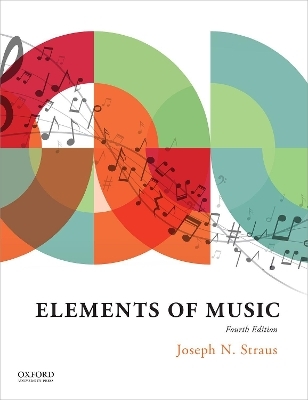
Elements of Music 4e
Oxford University Press Inc (Verlag)
978-0-19-754193-7 (ISBN)
Joseph N. Straus is a Distinguished Professor of Music Theory at the City of New York Graduate Center.
Preface
Acknowledgments
Chapter 1 Pitch
Lesson 1: Staff
The five-line staff, pitches and notes, noteheads, ascending and descending motion,
steps and leaps, ledger lines
Lesson 2: Keyboard
Piano keyboard, black and white keys, letter names for notes, steps and leaps, octaves, piano fingering
Lesson 3: Treble clef
Treble clef, accidentals (sharp, flat, and natural), semitones, enharmonic equivalence
Lesson 4: Bass clef
Bass clef, accidentals (sharp, flat, natural), semitones
Lesson 5: Great staff
Great staff
Chapter 1: Supplementary Lesson
Alto clef, tenor clef, octave signs (8va and 8vb), octave designations, double flats, and double sharps
Chapter 1: Self-Test
Chapter 2 Rhythm and Meter
Lesson 6: Quarter notes, half notes, and whole notes in 4/4 meter
Quarter notes, half notes, whole notes, stems, beats, measures (bars) and barlines, meter ("common time"), upbeat, downbeat, accent, conducting patterns, tempo
Lesson 7: Eighth notes and sixteenth notes
Eighth notes and sixteenth notes, flags, beams
Lesson 8: Dots and ties
Augmentation dot, dotted rhythms, ties, anacrusis
Lesson 9: Rests
Rests
Lesson 10: Duple meter
2/4 and 2/2 meter, upbeat, downbeat, conducting patterns
Lesson 11: Triple meter
3/4 meter and its conducting pattern
Lesson 12: Compound meter
Compound meter, 6/8 meter, and its conducting pattern
Lesson 13: Syncopation
Syncopation, accent marks, ties, and subdivision
Chapter 2: Supplementary Lesson
Stem direction, anacrusis, rhythmic values smaller than a sixteenth note, triplets, other duple, triple, and quadruple meters
Chapter 2: Self-Test
Chapter 3 Major and Minor Scales
Lesson 14: Major scale (C major)
Major scale, arrangement of semitones and whole tones, scale-degree numbers, scale-degree names, solfège syllables
Lesson 15: Major scales other than C major
Transposition, major scales with sharps, major scales with flats, circle of fifths
Lesson 16: Major keys and key signatures
Major keys and key signatures
Lesson 17: Minor scale (A minor)
Minor scale, arrangement of semitones and whole tones, scale-degree numbers, scale-degree names, solfège syllables, and raising scale-degrees
Lesson 18: Minor scales other than A minor
Transposition, minor scales with sharps, minor scales with flats, circle of fifths
Lesson 19: Minor keys and key signatures
Minor keys, minor key signatures, relative keys, parallel keys
Lesson 20: Harmonic and melodic minor
Harmonic minor and melodic minor scales
Chapter 3: Supplementary Lesson
Modes and the pentatonic scale
Chapter 3: Self-Test
Chapter 4 Intervals
Lesson 21: Interval size
Intervals, melodic and harmonic intervals, interval size, compound intervals
Lesson 22: Seconds and thirds
Interval quality, natural intervals, major and minor intervals, diminished and augmented intervals, enharmonically equivalent intervals
Lesson 23: Sixths and Sevenths
Sixths and sevenths, enharmonically equivalent intervals, interval inversion
Lesson 24: Fourths and fifths, unisons and octaves
Perfect intervals, fourths and fifths, unisons and octaves, interval inversion, enharmonically equivalent intervals
Lesson 25: Intervals in a major key
Intervals in a major key, intervals and scale degrees, consonance and dissonance
Lesson 26: Intervals in a minor key
Intervals in a minor key, intervals and scale degrees
Chapter 4: Supplementary Lesson
All intervals, doubly diminished and doubly augmented intervals, intervals in harmonic and melodic minor
Chapter 4: Self-Test
Chapter 5 Triads and Seventh Chords
Lesson 27: Triads
Triads (root, third, and fifth), triad qualities (major, minor, diminished, augmented), natural triads, chord symbols
Lesson 28: Triads in inversion
Soprano and bass, inversion of triads (root position, first inversion, second inversion), figured bass ( , , )
Lesson 29: Triads in major keys
Triad names, Roman numerals, triad qualities in major keys
Lesson 30: Triads in minor keys
Triad names, Roman numerals, triad qualities in minor keys, and the effect of raising the leading tone
Lesson 31: Seventh chords
Seventh chords, major-minor (dominant) seventh chords, inversions of seventh chords, dominant seventh chords in major and minor keys, figured bass symbols, chord names
Chapter 5: Supplementary Lesson
Qualities of seventh chords, natural seventh chords, inversions of seventh chords, and seventh chords in major and minor keys
Chapter 5: Self-Test
Chapter 6 Harmony and Form
Lesson 32: Tonic and dominant
Harmonic progression, tonic harmony, dominant and dominant seventh harmonies, harmonizing a melody
Lesson 33: Extending a harmonic progression
Dominant preparation chords (ii and IV), preceding a dominant preparation chord (vi), and moving directly from IV to I
Lesson 34: Phrase and cadence
Phrase, authentic cadence, half cadence, and plagal cadence
Lesson 35: Form
Combining four-measure phrases into longer groupings (eight-, twelve-, and sixteen-measure periods) and song forms (A-B-A and A-A-B-A)
Chapter 6: Supplementary Lesson
Nonharmonic tones, doubling, tendency tones, voice-leading smoothness, and parallel fifths and octaves
Glossary
| Erscheinungsdatum | 09.03.2021 |
|---|---|
| Verlagsort | New York |
| Sprache | englisch |
| Maße | 272 x 213 mm |
| Gewicht | 975 g |
| Themenwelt | Kunst / Musik / Theater ► Musik ► Musiktheorie / Musiklehre |
| ISBN-10 | 0-19-754193-3 / 0197541933 |
| ISBN-13 | 978-0-19-754193-7 / 9780197541937 |
| Zustand | Neuware |
| Haben Sie eine Frage zum Produkt? |
aus dem Bereich


